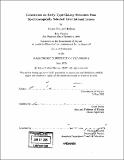Constraints on early-type galaxy structure from spectroscopically selected gravitational lenses
Author(s)
Bolton, Adam Stallard
DownloadFull printable version (16.61Mb)
Other Contributors
Massachusetts Institute of Technology. Dept. of Physics.
Advisor
Scott Burles.
Terms of use
Metadata
Show full item recordAbstract
This thesis describes all aspects of a unique spectroscopic survey for strong galaxy-galaxy gravitational lenses: motivation, candidate selection, ground-based spectroscopic follow-up, Hubble Space Telescope imaging, data analysis, and results on the radial density profile of the lens galaxies. The lens candidates are selected from within the spectroscopic database of the Sloan Digital Sky Survey (SDSS) based on the appearance of two significantly different redshifts along the same line of sight, and lenses are confirmed within the candidate sample by follow-up imaging and spectroscopy. The sample of [approx.] 20 early-type lenses presented in this thesis represents the largest single strong-lens galaxy sample discovered and published to date. These lenses probe the mass of the lens galaxies on scales roughly equal to one-half effective radius. We find a dynamical normalization between isothermal lens-model velocity dispersions and aperture-corrected SDSS stellar velocity dispersions of ... By combining lens-model Einstein radii and de Vaucouleurs effective radii with stellar velocity dispersions through the Jeans equation, we find that the logarithmic slope [gamma] of the density profile in our lens galaxies ... is on average slightly steeper than isothermal ( [gamma] = 2) with a modest intrinsic scatter. Parameterizing the intrinsic distribution in [gamma] as Gaussian, we find a maximum-likelihood mean of ... and standard deviation of ... (68% confidence, for isotropic velocity-dispersion models). Our results rule out a single universal logarithmic density slope at > 99.995% confidence. (cont.) The success of this spectroscopic lens survey suggests that similar projects should be considered as an explicit science goal of future redshift surveys.
Description
Thesis (Ph. D.)--Massachusetts Institute of Technology, Dept. of Physics, 2005. Includes bibliographical references (p. 159-166).
Date issued
2005Department
Massachusetts Institute of Technology. Department of PhysicsPublisher
Massachusetts Institute of Technology
Keywords
Physics.